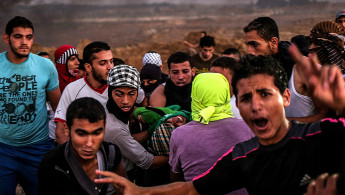The power of viral videos in West Bank unrest
The whole incident was caught on camera.
The video, which was quickly uploaded by both Israelis and Palestinians, was far from the first to go viral as attacks and unrest have spread over the past couple weeks, but it was perhaps one of the most controversial.
According to Israeli police, Ahmad, and his 15-year-cousin, Hassan, stabbed a man at the Pisgat Zeev settlement in East Jerusalem on Monday before attacking and critically wounding a 13-year-old Jewish boy on a bicycle.
Police said Hassan died after being hit by a car as he fled, while security forces shot Ahmad when he tried to charge at them with a knife.
After he was shot, onlookers hailed abuse at Ahmad as he lay bleeding.
"Die you f*****, die you son of a whore, you son of 66 whores," one can be seen shouting in the video.
The video, shared by thousands on social media, became known as the “new Dara”, in reference to a Palestinian child photographed being shot in Gaza during the second intifada, as his father tried to shield him.
Viral videos
Ahmad's video is not the only one to have gone viral. Since the latest escalation, which erupted October 1, many people have been sharing such videos over social media to highlight the Palestinian perspective of the conflict.
On Tuesday morning, a video emerged of Israeli settlers discussing whether to kill a Palestinian girl they had pinned to the ground, after accusing her of having a knife. But no weapon is visible.
The same day, another video circulated of Israeli security forces detaining a Palestinian man who was working in sanitation at the Yaffa municipality. Settlers claimed the man was trying to carry out a stabbing attempt against Israelis.
One of the most shared videos was that of an elderly Palestinian man, Abu Khalil from Hebron. In the footage he is seen approaching Israeli security forces, as he tells them to drop their weapons and not fire at children.
At the end of the video, Abu Khalil collapses.
|
|
||
| Abu Khalil approaching Israeli security forces is caught on camera |
Over the weekend, an Israeli airstrike killed a pregnant Palestinian woman and her two-year-old daughter in Gaza.
A video showed the devastation post-strike, as the father and husband of the killed is seen mourning for his family, clutching his daughter.
Last week, a video was seen of an unarmed young Palestinian woman, holding her hands in the air, while surrounded by Israeli soldiers. She was then shot.
'Reminded of their condition'
Rebecca Stein, co-author of a book tracking how social media has been used politically by Israelis in recent years, said the battle for control of narratives has intensified.
In 2008, the first of three conflicts in Gaza since then, Internet penetration in Palestinian communities was limited.
However, during last year's most-recent conflict, Gazans were constantly posting videos online, she said.
"The images of stabbings are shared by some Israelis as evidence of age-old hatred of Jews, but by some Palestinians they are held up as resistance to occupation," said Stein.
Israeli officials have sought to limit the use of social media to spread what it sees as incitement, requesting that YouTube take down certain types of videos.
But Dina Matar, of the Centre for Media Studies at SOAS in London and author of "What It Means to be Palestinian", said that within Palestinian communities viral videos are more representative of frustration than a cause of it.
"When they see this video they are reminded of their condition," she said.
Eyal Naveh, a professor at Tel Aviv University and co-author of "Side by Side: Parallel Histories of Israel-Palestine", pointed out that "both sides [use images] for what they want to prove."
The violence of the image intensifies the hatred," he said.
Although the authenticity of the videos mentioned have not been disputed, various different narratives and reports surround them.
For many Palestinians, the video is proof of the brutality of the Israeli security forces. But for many Israelis, it is proof of the threat posed by Palestinians. Each side interprets the videos as evidence in support of its cause.



